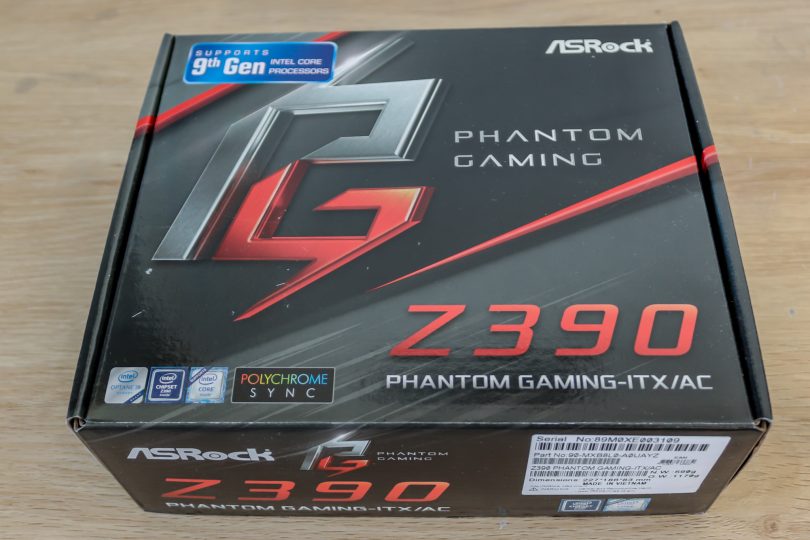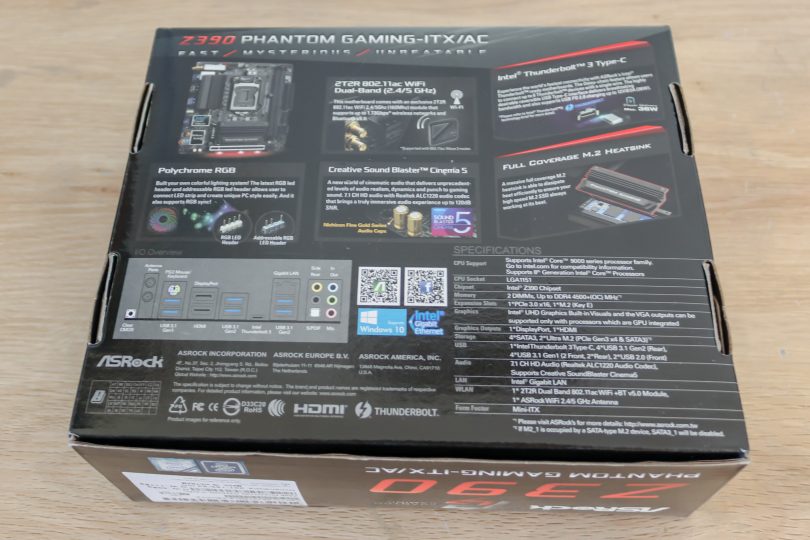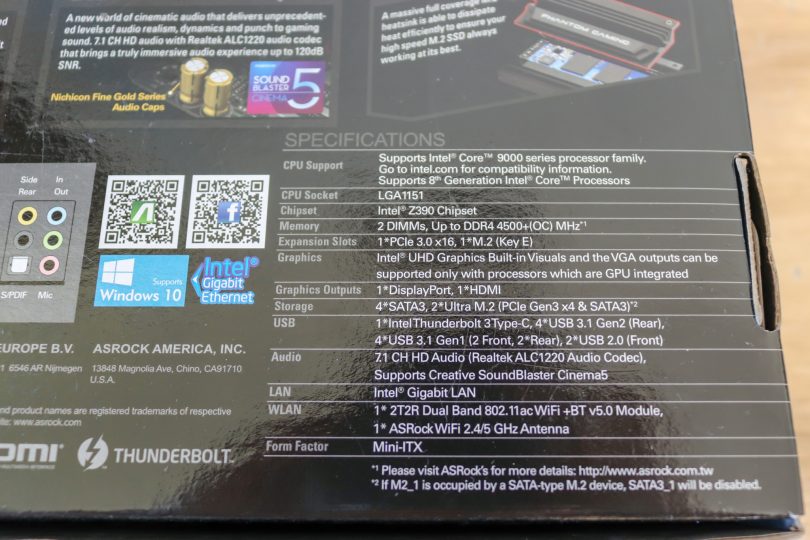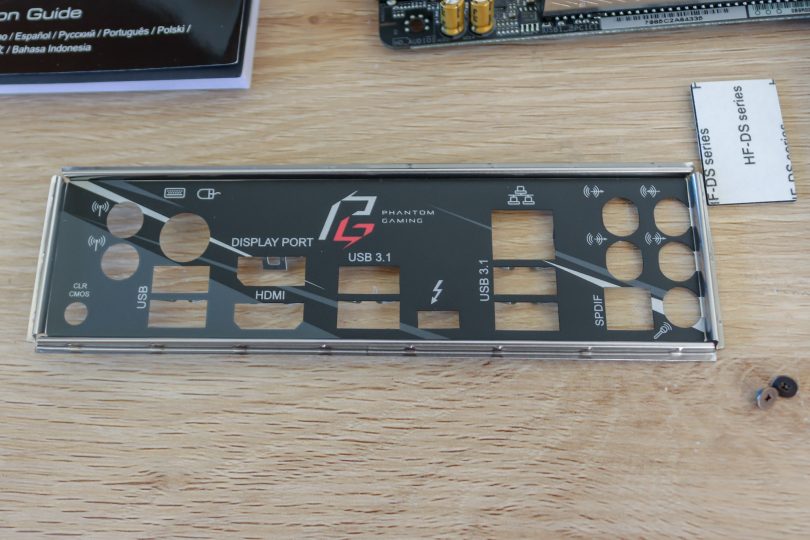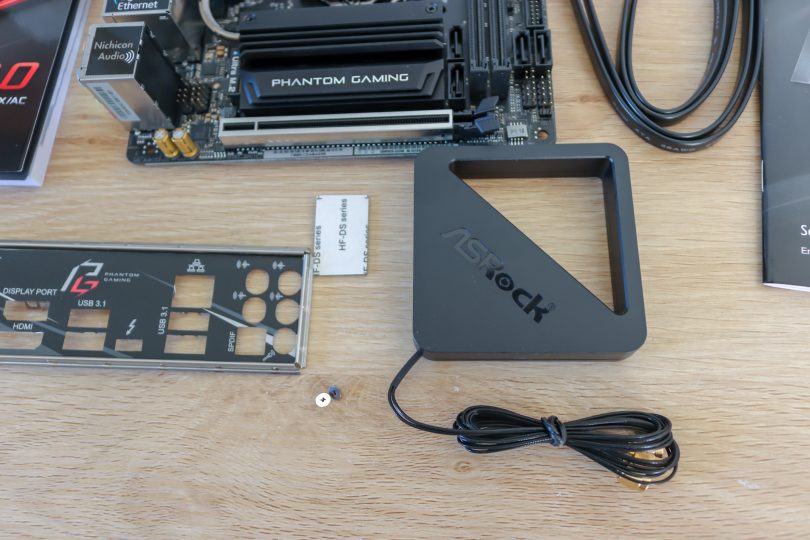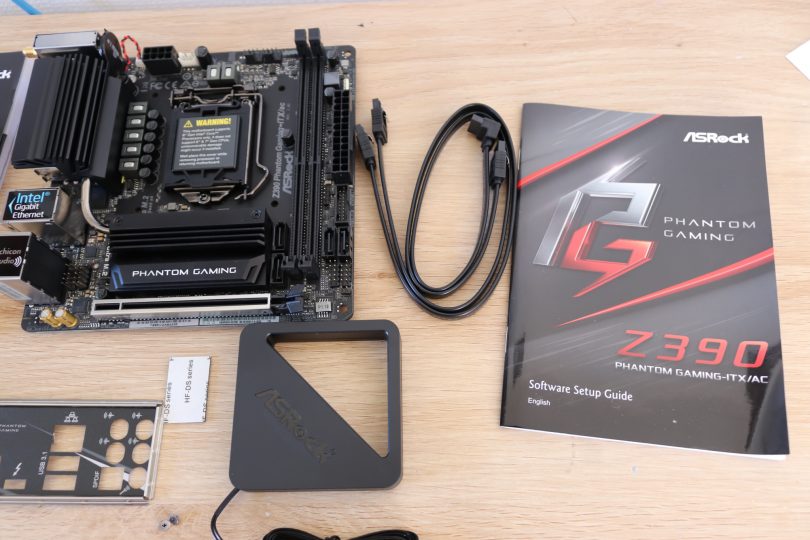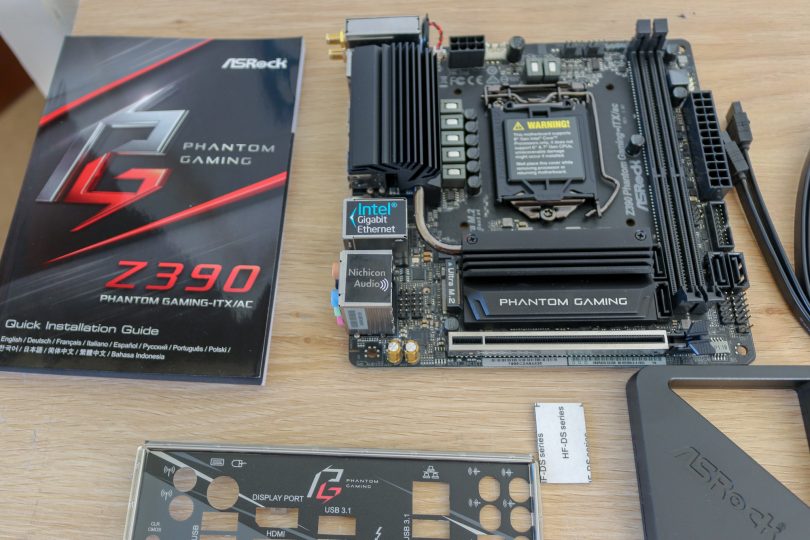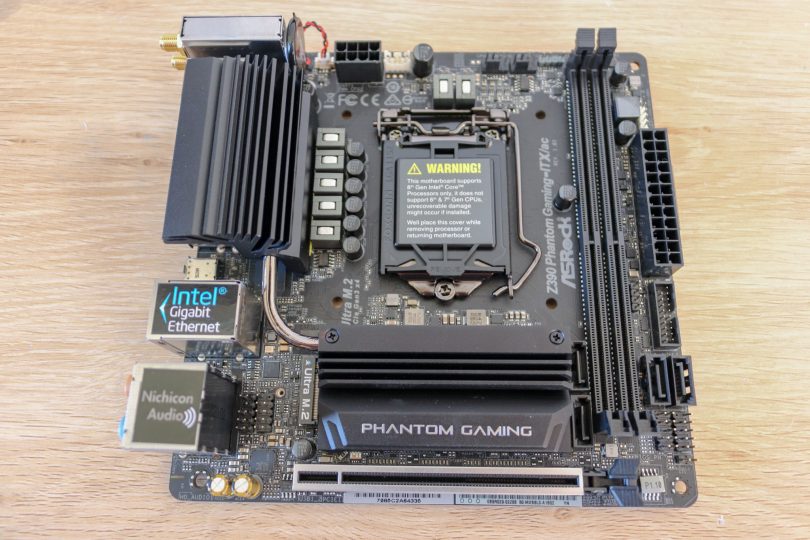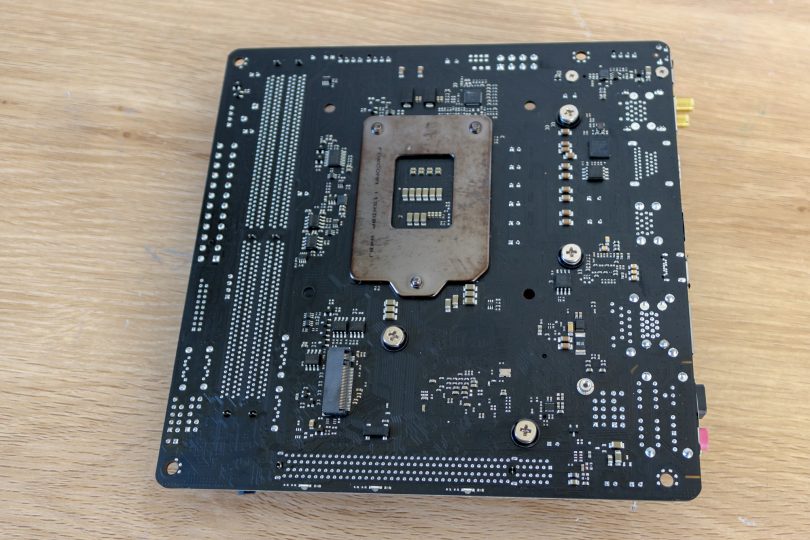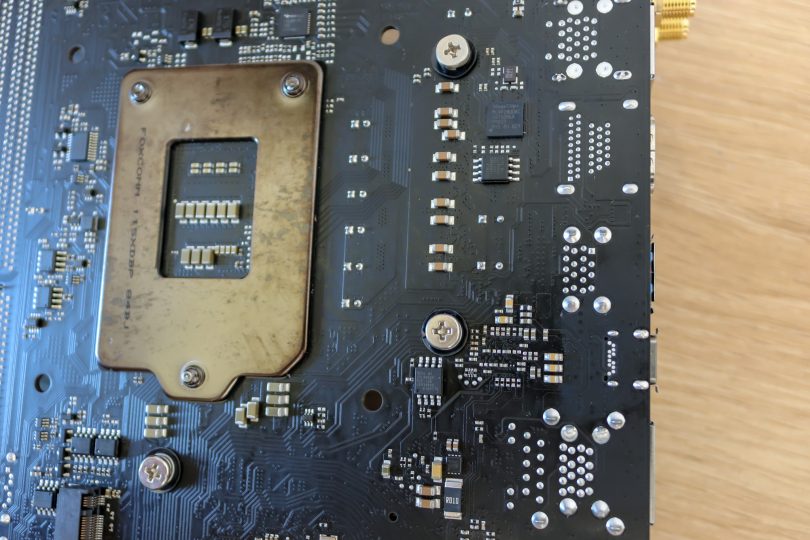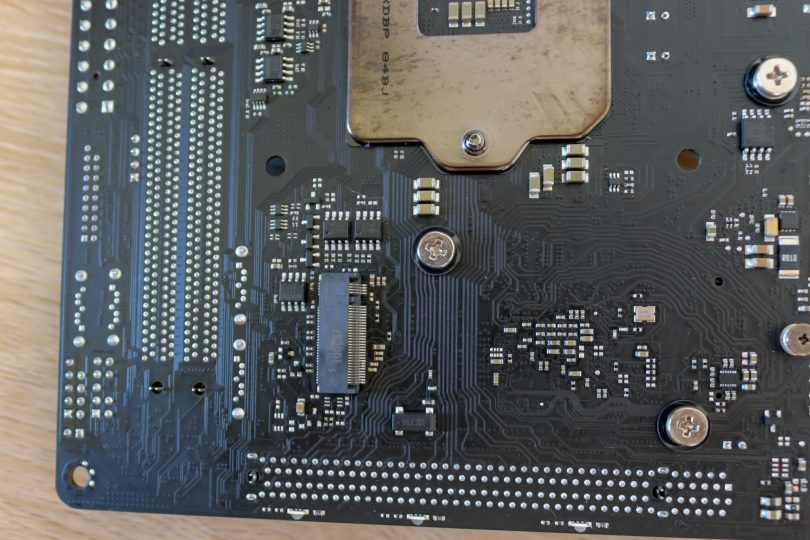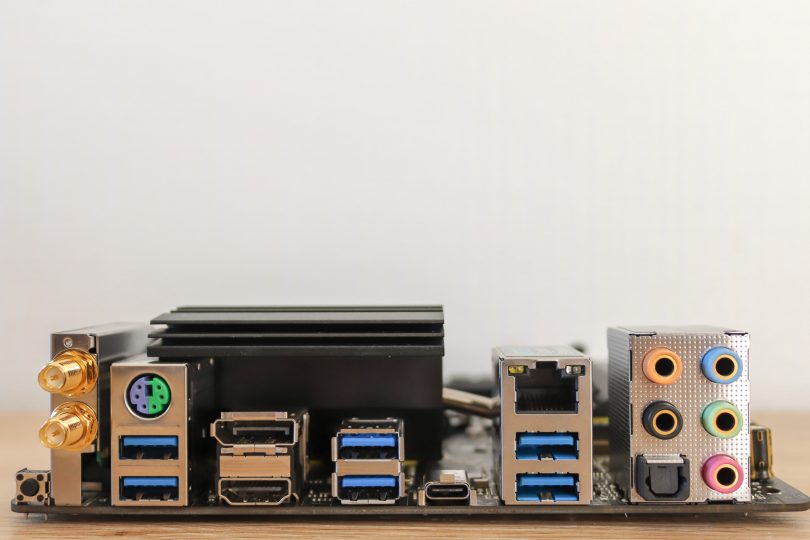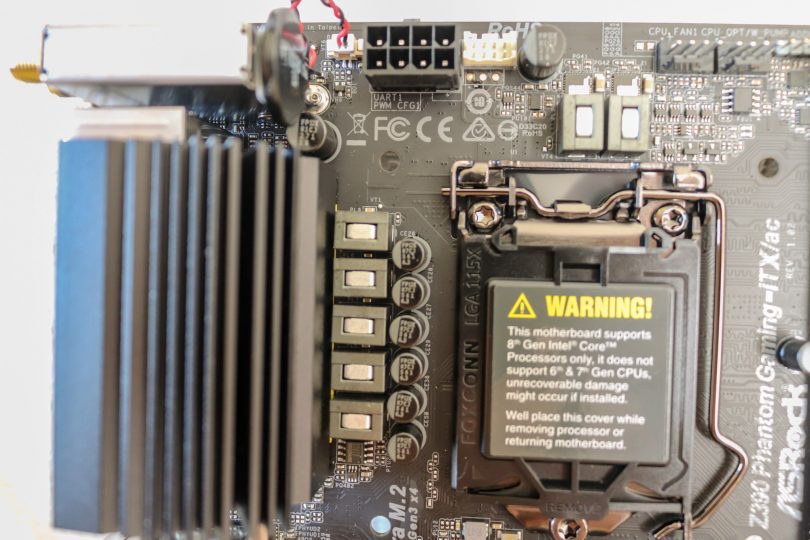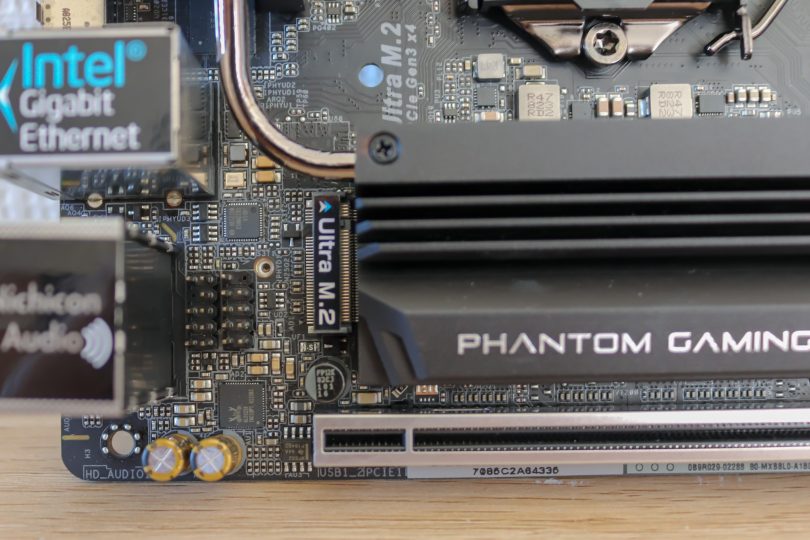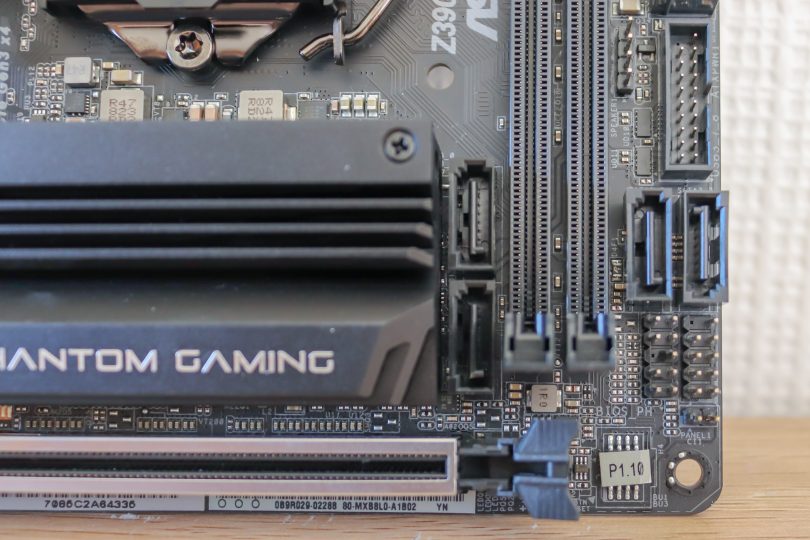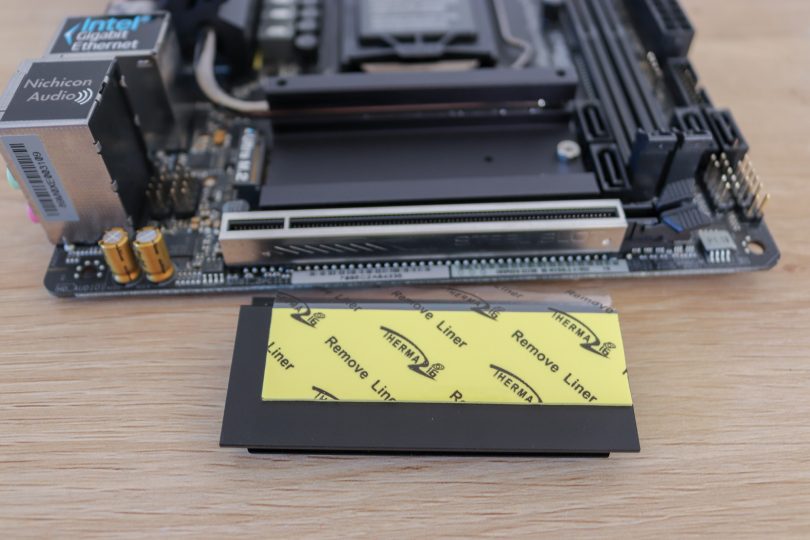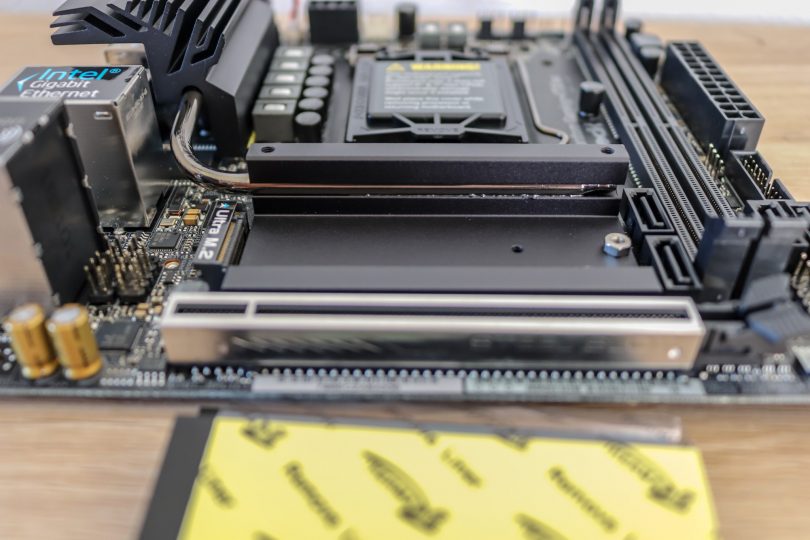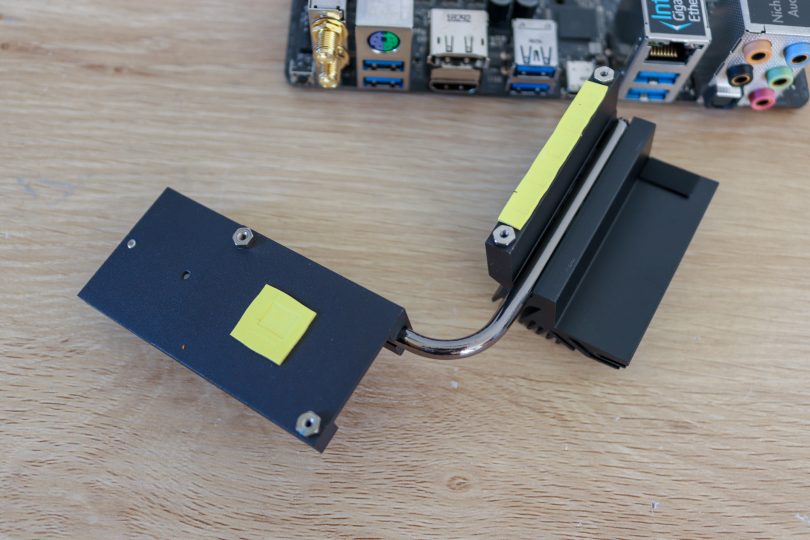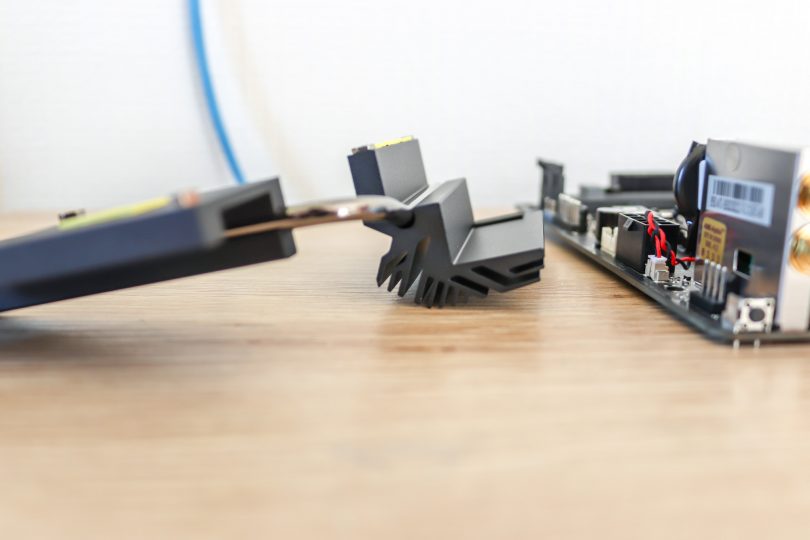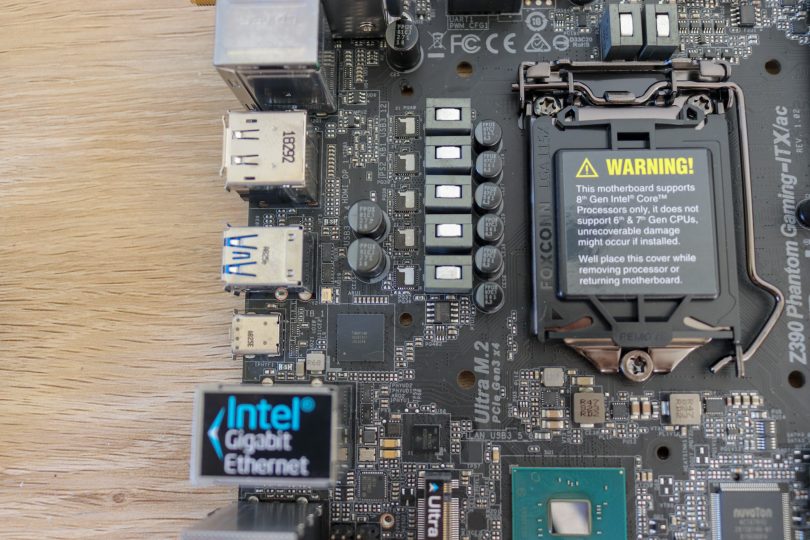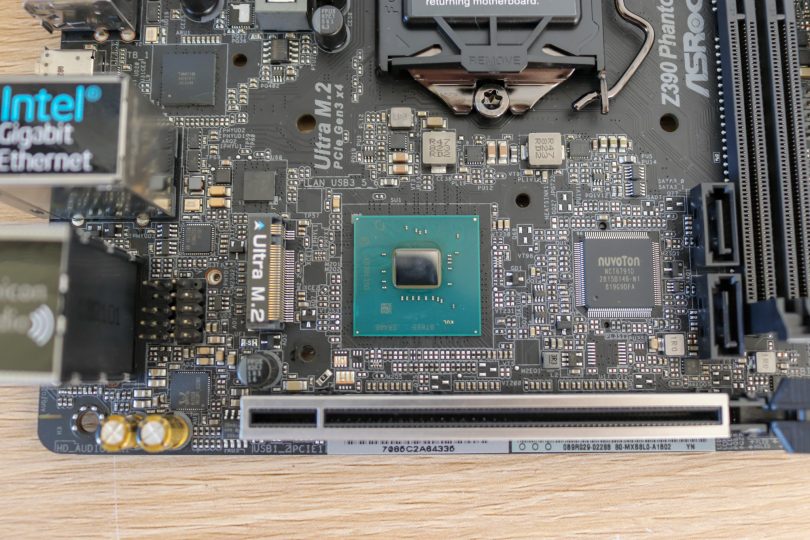For some time, ASRock has been using the Fatal1ty branding on their high end products – a tie back to the days of old, where Quake was king, and bright, flashy branding was cool. However, Fatal1ty has given way to ASRock’s “Phantom Gaming” brand, with a much more subtle aesthetic. All black? Yes please! Beefy heatsinks? Yessir!
First sighted on ASRock’s limited availability (unfortunately) GPU line, the Phantom Gaming brand has come to motherboards – slowly taking over the performance space within ASRock’s lineup. This particular model uses the Intel Z390 chipset – what Z370 should have been, but I digress.
Let’s dive in!
Table of Contents
The Specifications
Reproduced from the product page and edited for clarity.
| Model | Phantom Gaming-ITX/ac |
| CPU Support | Intel LGA1151, Intel 8th and 9th gen processors (8000/9000 series) |
| Chipset | Intel Z390 |
| Memory | – Dual Channel DDR4 Memory Technology – 2 x DDR4 DIMM Slots – Supports DDR4 4500+(OC) / 4333-2800(OC)/ 2666 / 2400 / 2133 non-ECC, un-buffered memory – Supports ECC UDIMM memory modules (operate in non-ECC mode) – Max. capacity of system memory: 32GB – Supports Intel® Extreme Memory Profile (XMP) 2.0 – 15μ Gold Contact in DIMM Slots |
| BIOS | – 128Mb AMI UEFI Legal BIOS with multilingual GUI support – ACPI 6.0 Compliant wake up events – SMBIOS 2.7 Support – DRAM, VTT DDR, PCH +1.0, VCCIO, VCCPLL_V5, VCCST_SFR, VCCSA, VCCPLL, VCCPLL_V4, V_PEGRCOMP Voltage Multi-adjustment |
| Integrated Graphics | – Supports Intel® UHD Graphics Built-in Visuals : Intel® Quick Sync Video with AVC, MVC (S3D) and MPEG-2 Full HW Encode1, Intel® InTru™ 3D, Intel® Clear Video HD Technology, Intel® Insider™, Intel® UHD Graphics – DirectX 12 – HWA Encode/Decode: AVC/H.264, HEVC/H.265 8-bit, HEVC/H.265 10-bit, VP8, VP9 8-bit, VP9 10-bit (Decode only), MPEG2, MJPEG, VC-1 (Decode only) – Three graphics output options: HDMI, DisplayPort 1.2 and Intel® Thunderbolt™ 3 – Supports Triple Monitor – Supports HDMI 2.0 with max. resolution up to 4K x 2K (4096×2160) @ 60Hz – Supports DisplayPort 1.2 with max. resolution up to 4K x 2K (4096×2304) @ 60Hz – Supports Intel® Thunderbolt™ 3 with max. resolution up to 4K x 2K (4096×2304) @ 60Hz – Supports Auto Lip Sync, Deep Color (12bpc), xvYCC and HBR (High Bit Rate Audio) with HDMI 2.0 Port (Compliant HDMI 2.0 monitor is required) – Supports HDR (High Dynamic Range) with HDMI 2.0 – Supports HDCP 2.2 with HDMI 2.0, DisplayPort 1.2 and Intel® Thunderbolt™ 3 – Supports 4K Ultra HD (UHD) playback with HDMI 2.0, DisplayPort 1.2 and Intel® Thunderbolt™ 3*Intel® UHD Graphics Built-in Visuals and the VGA outputs can be supported only with processors which have GPU integrated. |
| Audio | – 7.1 CH HD Audio with Content Protection (Realtek ALC1220 Audio Codec) – Premium Blu-ray Audio support – Supports Surge Protection – Nichicon Fine Gold Series Audio Caps – 120dB SNR DAC with Differential Amplifier – NE5532 Premium Headset Amplifier for Front Panel Audio Connector (Supports up to 600 Ohm headsets) – Pure Power-In – Direct Drive Technology – PCB Isolate Shielding – Impedance Sensing on Rear Out port – Individual PCB Layers for R/L Audio Channel – Gold Audio Jacks – 15μ Gold Audio Connector – Supports Creative Sound Blaster™ Cinema 5 |
| Wired LAN | – Gigabit LAN 10/100/1000 Mb/s – Giga PHY Intel® I219V – Supports Wake-On-LAN – Supports Lightning/ESD Protection – Supports Energy Efficient Ethernet 802.3az – Supports PXE |
| Wireless LAN | – Intel® 802.11ac WiFi Module – Supports IEEE 802.11a/b/g/n/ac – Supports Dual-Band (2.4/5 GHz) – Supports high speed wireless connections up to 1733Mbps – 2 antennas to support 2 (Transmit) x 2 (Receive) diversity technology – Supports Bluetooth 5.0 + High speed class II – Supports MU-MIMO |
| Expansion slots | – 1 x PCI Express 3.0 x16 Slot (PCIE1: x16 mode)* – 1 x Vertical M.2 Socket (Key E) with the bundled WiFi-802.11ac module and Intel® CNVi (Integrated WiFi/BT) (on the rear I/O) – 15μ Gold Contact in VGA PCIe Slot (PCIE1)*Supports PCIe riser cards to extend one x16 slot to two x8 slots Supports NVMe SSD as boot disks |
| Storage | – 4 x SATA3 6.0 Gb/s Connectors, support RAID (RAID 0, RAID 1, RAID 5, RAID 10, Intel® Rapid Storage Technology 16), NCQ, AHCI and Hot Plug* – 1 x Ultra M.2 Socket (M2_1), supports M Key type 2280 M.2 SATA3 6.0 Gb/s module and M.2 PCI Express module up to Gen3 x4 (32 Gb/s)** – 1 x Ultra M.2 Socket (M2_2), supports M Key type 2260/2280 M.2 SATA3 6.0 Gb/s module and M.2 PCI Express module up to Gen3 x4 (32 Gb/s)***If M2_1 is occupied by a SATA-type M.2 device, SATA3_1 will be disabled.**Supports Intel® Optane™ Technology Supports NVMe SSD as boot disks |
| Internal Connectors | – 1 x Chassis Intrusion Header – 1 x RGB LED Header* – 1 x Addressable LED Header** – 1 x CPU Fan Connector (4-pin)*** – 1 x CPU/Water Pump Fan Connector (4-pin) (Smart Fan Speed Control)**** – 1 x Chassis Fan Connector (4-pin)***** – 1 x 24 pin ATX Power Connector – 1 x 8 pin 12V Power Connector (Hi-Density Power Connector) – 1 x Front Panel Audio Connector (15μ Gold Audio Connector) – 1 x USB 2.0 Header (Supports 2 USB 2.0 ports) (Supports ESD Protection) – 1 x USB 3.1 Gen1 Header (Supports 2 USB 3.1 Gen1 ports) (Supports ESD Protection)*Supports in total up to 12V/3A, 36W LED Strip **Supports in total up to 5V/3A, 15W LED Strip ***The CPU Fan Connector supports the CPU fan of maximum 1A (12W) fan power. ****The CPU/Water Pump Fan supports the water cooler fan of maximum 2A (24W) fan power. CPU_OPT/W_PUMP can auto detect if 3-pin or 4-pin fan is in use. *****The Chassis Fan Connector supports the chassis fan of maximum 1A (12W) fan power. |
| Rear Panel I/O | – 2 x Antenna Ports – 1 x PS/2 Mouse/Keyboard Port – 1 x HDMI Port – 1 x DisplayPort 1.2 – 1 x Intel® Thunderbolt™ 3 (Compatible with USB 3.1 Gen2 and USB-C Display)* – 1 x Optical SPDIF Out Port – 4 x USB 3.1 Gen2 Type-A Ports (10 Gb/s) (Supports ESD Protection) – 2 x USB 3.1 Gen1 Ports (Supports ESD Protection) – 1 x RJ-45 LAN Port with LED (ACT/LINK LED and SPEED LED) – 1 x Clear CMOS Button – HD Audio Jacks: Rear Speaker / Central / Bass / Line in / Front Speaker / Microphone (Gold Audio Jacks)*Supports USB PD 2.0 up to 12V@3A (36W) charging |
| Accessories | – Quick Installation Guide, Support CD, I/O Shield – 2 x SATA Data Cables – 1 x ASRock WiFi 2.4/5 GHz Antenna – 2 x Screws for M.2 Sockets |
The ASRock Z390 Phantom Gaming-ITX/ac is retailing for US$179.99 at Newegg.com at the time of writing.
The Unboxing
Black is the order of the day, replacing the primarily red branding of products past.
The rear side of the box includes the usual marketing;
…and a spec table that has been reproduced above.
Included in the package, the usual accoutrements – an IO shield – in a much more subtle style than previous.
As well as the I/O shield, we also have a pair of M.2 retention screws, a WiFi antenna and a sticky pad for the aforementioned antenna.
A pair of SATA cables, and a software setup guide…
… and finally, a full quick installation guide in multiple languages. Hiding inside the manual is a driver CD, complete with case badge.
The ASRock Z390 Phantom Gaming-ITX/ac
What a moniker! However, the long, gamer-esque name belies the subtlety of the aesthetic. No bright colours, bold graphics, or other gimmickry, just a well designed board. Using what is now a common layout, ample clearance is available for CPU coolers, memory and other expansion.
The WiFi solution sits near the top of the board, channeling the integrated WiFi in the Z390 chipset to the rear panel. Power input lies in two areas – the CPU input to the top left, and the ATX power input to the far right. These have become the normal locations – to the extent that some case manufacturers have been designing cable management for such designs, NFC being one example.
The back holds a sole M.2 slot – one of a pair on this board. We’re starting to see M.2 become a prevalent storage form factor over SATA, so the more the merrier.
Under the rear IO, a plethora of supporting circuitry is to be found. Most visible are the three chips – a MegaChips MCDP2800BC and a pair of MXIC MX25L8006E.
The MCDP2800BC is a DisplayPort 1.2a to HDMI 2.0 convertor chip – an interesting choice as the Coffee Lake IGP is only HDMI 1.4. A handy upgrade!
The MX25L8006E (PDF link) appears to be a SPI bus component, but that, alas, is above my knowledge set!
Down to the rear M.2 slot – supporting either SATA3 6.0Gb/s or PCIe Gen 3 x4 (32 Gb/s). I’d recommend the latter. At the bottom of the board are a few red LEDs – these can be disabled in BIOS.
To the top of the CPU retention plate is an Renesas/Intersil ISL69138 (PDF link) – a PWM controller. This chip is a specifically designed solution for controlling the CPU, RAM and system bus power supplies on an Intel platform board.
Above the pair of Nuvoton 3101S Bus Termination Regulators (PDF link) and supporting circuitry (these support the RAM subsystem) is a N76E885AT28, one of a family of microcontrollers from Nuvoton. These are general purpose microcontrollers.
The rear I/O is fully featured, with a clear CMOS button, WiFi ports, PS/2 combo port, a pair of USB3.1 Gen 1, DisplayPort 1.2, HDMI 2.0 (courtesy of the aforementioned MegaChips converter), a pair of USB 3.1 Gen 2 ports, a Thunderbolt 3 port (I’ll dig into this in a little bit), RJ45 for the gigabit ethernet port, another pair of USB 3.1 Gen 2 ports, and finally, the audio stack.
The Thunderbolt 3 port has been a controversial matter in a way. While this port supports USB3.1 Gen 2, as well as USB-C display outputs, it is limited in its bandwidth versus full-fat Thunderbolt 3 products. This is an artifact of using only a pair of PCIe lanes rather than the typical quad lane specification – leading to a roughly 16 Gb/s pipeline versus a possible 40 Gb/s.
To the top side of the board. A pair of 4 pin PWM headers are present – a CPU fan header and a CPU secondary fan or waterpump header. To the right of these is an addressable RGB header (of course). The white 4 pin header to the far right is an RGB header for the plebians with regular RGB strips.
Chip time! Under the CPU_OPT PWM header is a Nuvoton 3947SA – a PWM fan controller IC. A pair of QFP ICs – one marked 3T=S5D S1Q , and the bottom-most being 1200 798 AD15 (both of which my Google-fu failed on).
From top to bottom on the right side of the RAM slots –
- 8991A 80355M – marked as an LED controller
- SM 3337 CU32H (PDF link) – P-Channel MOSFET
- 7341EH OU01 (PDF Link) – Dual channel P-channel MOSFET
- 4034GYT 805K9E (PDF Link) N-Channel MOSFET
- Another SM 3337 CU32H
Next to the 8 pin power input is an 8 pin UART header. To the left of the Foxconn made CPU socket, the inductors (claimed to handle 60A each!) and caps for the CPU power section are nestled into the heatsink for the MOSFETs.
Down to the bottom left, where we find the Nichicon capacitor based audio section. Controlled by a Realtek ALC1220 audio codec, ASRock claims a 120dB SNR DAC – pretty good if it stacks up. Alas, I don’t have the hardware, or the ears, to test this.
The front panel audio header is powered by a NE5532, powerful enough to run 600 ohm headphones. To the right, a USB 2.0 front panel header.
Below this legacy header is the aformentioned Realtek ALC1220 IC. Above the header, a WGI219V Intel ethernet PHY chip.
The quartet of SATA connectors are split by the RAM slots – belying their secondary nature to a modern ITX system. Under the rightmost SATA ports are the front panel header to the right, and a BIOS programming header to the left.
To the left of the front panel USB3.0 front panel header are a pair of chips marked “136 hhUHG”. ¯\_(ツ)_/¯
The board came with BIOS revision 1.10 – at time of writing, the BIOS version is up to 1.30 – a few tweaks and fixes have been done since this review unit was shipped to me.
Inside the two-part chipset/VRM heatsink assembly we find a ThermaL 16 16 pad – 1.6mm thick and from a brand I’m not aware of. In the near future, I plan on testing the efficacy of this mounting location as to cooling – it was not something I was able to test at time of writing.
The heatpipe is around 5mm in diameter, and dark nickel plated.
The VRM, chipset and M.2 heatsink array takes centre stage – made from black anodised aluminium with a sole heatpipe to share the load between the heat sources.
A hefty chunk of aluminium. Whilst the aesthetics are subtle, there’s enough surface area to really suck some heat from the VRMs.
A quintet of Fairchild Semiconductor 76AS 30V 90A (!) MOSFETs power the CPU and Z390 chip.
Below the power section lies a behemoth BGA – the Intel JHL6240 Thunderbolt Controller (Alpine Ridge).
The shinier BGA just above the M.2 slot is a Texas Instrument TPS65982DA (PDF link), a USB Type-C power controller.
Taking centre stage is a package denoted SR406 – Intel’s Z390 chipset. To the right of this is the Nuvoton NCT6791D, the expected “Super IO” chip.
The Experience
Whilst the unboxing experience is as per the norm, it’s the experience in the build and use that really defines the product. As usual, the initial installation of components into the board went smoothly, with no cooler conflicts with Noctua NH-L9i I attached. Everything feels robust and of high quality. All I/O had drivers already in Windows 10 – no downloading of drivers was needed to get the initial system working.
Installing my ADATA XPG NVMe SSD was also an interesting experience – the heatsink on the drive meant that it could not be mounted to the combination heatsink assembly on the top of the board. I removed the drive’s heatsink and all went well as to the installation. I have noted a substantial decrease (~20C) in drive temperatures versus the drive’s original heatsink – but I’m not surprised considering the heft of the board’s cooler, versus the thin aluminium piece that came with the drive.
Upgrading the BIOS from P1.10 to the current P1.3 was fraught with terror – the process became stuck 3 times, with only a mains power cycle each time allowing the system to boot. Three times I thought the board was bricked! This was using the UEFI flash utility – I did not attempt to use the Windows based tool. Not great. Thankfully, I managed to get the process finished in the end.
The Conclusion
The ASRock Z390 Phantom Gaming-ITX/ac epitomises what should be the target for modern SFF motherboard design – subtle aesthetics, full feature set and great build quality. The board is exactly what I think a high end M-ITX board should be – no flashy G4M3R graphics, garish heatsinks and poor I/O decisions that plague other boards (links are just some of many, many examples). Well done ASRock.
I do have a couple of suggestions for ASRock though – little changes to tip this over the edge from a good product, into a great one.
- Full 4x lane Thunderbolt 3
- Shorten that name!
- Let the “Smart Button” that is denoted for clearing the CMOS become a dual function button like on the X299e-ITX/ac – the power button mode is invaluable!
- Include spacers to enable the M.2 heatsink assembly to be used with NVMe drives that have coolers attached
Can I recommend the ASRock Phantom Gaming-ITX/ac? Notwithstanding the inherent flaws with Intel’s product stacks, the feature set present on this motherboard, for the price it retails at, offers a solid option if you want the best you can get.
Pros
- Fantastic aesthetics
- Great build quality
- Good feature choices
- Only Z390 ITX board with Thunderbolt at time of writing
Cons
- x2 rather than x4 Thunderbolt 3
- Intel’s product stack is a nightmare – no fault of ASRock’s, though
- Sketchy BIOS update
- Only bare NVMe drives will fit the heatsink assembly.
Niggles
- WiFi antenna could benefit from a magnet to stick to metal surfaces and add heft
- Dat name tho!
Thoughts? Discuss them in the forum.
This review sample was provided by ASRock.
Here at SmallFormFactor.net we give manufacturers the ability to be part of the community. We offer a right to reply to our hardware reviews. If a manufacturer responds with any feedback or corrections, their comments will be posted here.

